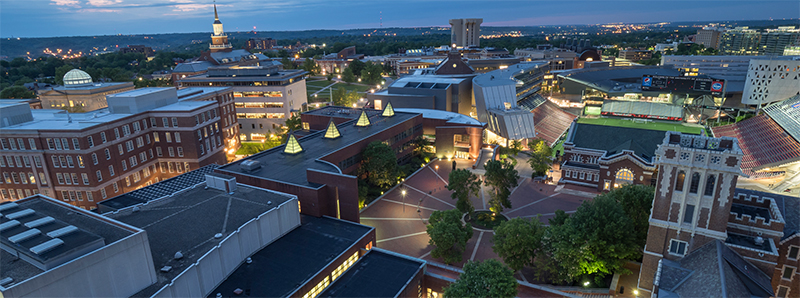Field Trips

Sunday, June 2nd Field Trips Cincinnati Zoo and Botanical Gardens The Zoological Society of Cincinnati was founded in 1873 and officially opened its doors in 1875, making the Cincinnati Zoo & Botanical Garden the second oldest Zoo in the United States. The Zoo’s original animal collection was very small, originally consisting of just eight monkeys, two grizzly bears, three deer, six raccoons, two elk, a buffalo, a hyena, a tiger, an alligator, a circus elephant, and over four hundred birds, including a talking crow. The Zoo was founded on 65 acres in the middle of the city, and since then has acquired some of the surrounding blocks and several reserves in Cincinnati’s suburbs. The Zoo was designated as a National Historic Landmark in 1987 due to its significant architecture featured in the Elephant House, the Reptile House, and the Passenger Pigeon Memorial. The Zoo’s Reptile House is the oldest existing Zoo building in the country, dating from 1875. Fee: $15Participants: 5-30 Time: 1-3pm You would have to travel a long distance to visit a rainforest or a desert – or you can come to Krohn Conservatory, Cincinnati Parks’ nationally recognized showcase of more than 3,500 plant species from around the world. The permanent collection includes desert plants, tropical specimens, Bonsai trees, rare orchids, carnivorous plants and exotic fruit trees. Krohn Conservatory was built in 1933 at the height of the Art Deco era. Boasting five unique floral shows annually, including the ever-popular “Butterfly Show,” which can be viewed mid-March through mid-June. During that time, thousands of butterflies are free to fly throughout the show room in a specially-themed garden. Fee: $15 Fort Ancient Archaeological Park In Warren County, Ohio, an isolated peninsula rises 80 meters (about 260 feet) above the muddy banks of the Little Miami River. There exists an immense monument to the dedication and technological savvy of the original inhabitants of prehistoric North America. This vast 51 hectare (about 126 acres) plateau is enclosed by embankment walls that stand 1.5 to 7 meters (about 5 to 23 feet) high, constructed by repeatedly dumping baskets loaded with soil upon one another. The Hopewell, known for their engineering expertise, built these walls and many other features both within the enclosure and on the steep valleys that surround the site: conical and crescent-shaped mounds, limestone pavements and circles, and many subsurface elements that are currently coming to light. Today, the Fort Ancient Earthworks & Nature Preserve is listed on the National Register of Historic Places because of its importance to Ohio prehistory. Fee: $15 Shawnee Lookout - CANCELLED Shawnee Lookout is well known for its historical Springhouse School and Log Cabin and Native American archaeological earthworks. The park's nature trails, including the 1.3-mile Blue Jacket, 2.0-mile Little Turtle and the 1.4-mile Miami Fort trail, offer spectacular views of the Ohio River and Great Miami River valleys. The park also features picnic areas, a playground and boat access to the Great Miami River. Fee: $15 Currently on the National Register of Historic places, the Whitewater Shaker settlement is the last standing Shaker community in the Midwest. Many of the buildings have been restored or are in the process of restoration. Although a small sect, the Shakers have had an outsized influence on the American psyche and cultural mindset. Among many other qualities, the Shakers were well known for their industrious marketing of medicinal plant tinctures and garden seeds. In many ways they were the “Burpee” seed sellers of the 19th century. In 1863, during the height of the Civil War, the White Water Shakers entered into the pages of American history through an encounter with Morgan’s Confederate Raiders. The field trip will include a tour of the major structures, agricultural facilities and other points of interest. Fee: $15
Big Bone Lick State Historic Site Big Bone Lick is a unique state park showcasing the remains of some of America’s most intriguing Ice Age Megafauna. Once covered with swamps, the land that makes up Big Bone Lick featured a combination of odorous minerals and saline water that animals found difficult to resist. Big Bone Lick’s museum exhibits are fresh and new! The park, in cooperation with the Friends of Big Bone and the Cincinnati Museum Center, worked together to create and produce all new exhibits for the park’s Visitor Center. Work on the final phase of exhibit installation is now complete. We encourage you to plan a visit to Big Bone Lick soon to see our exciting new displays on paleontology, Ordovician geology, ice age mammals, Native American history, the chronology of science at Big Bone, and ongoing research currently underway at the park. Fee: $15 Cincinnati Civic Garden Center The Civic Garden Center (CGC) is a non-profit horticultural resource whose mission is building community through gardening, education and environmental stewardship. Founded in 1942, the CGC is the only organization of its kind in our region. Here we host classes, a horticultural library, several gardens for visitors to enjoy free of charge, the Green Learning Station and an outdoor compost classroom. From the earliest classes in Victory Gardening to our most recent project focusing on sustainable gardening methods, the Green Learning Station, the Civic Garden Center has become the place to learn about gardening in the tri-state area. The grounds of the Civic Garden Center and Hauck Botanic Gardens are free to the public so explore as Mr. Hauck intended or follow some of our guided maps. Fee: $15 Edge of Appalachia Nature Preserve One of the most biodiverse natural areas in the region, the Richard and Lucile Durrell Edge of Appalachia Preserve System is located in Adams County, Ohio, and one of the largest privately-owned preserves east of the Mississippi. The name comes from the location on the western flank or "edge" of the Appalachian Escarpment. It consists of eleven unique preserves including: Ohio Brush Creek, Cedar Falls, The Wilderness, Buzzardroost Rock, Red Rock, Lynx Prairie, Cave Hollow, Hanging Prairie, Germany Hill Prairie, Abner Hollow and the Rieveschl Preserves. Four of these sites have been recognized as National Natural Landmarks — a testimony to their national significance and ecological importance. Fee: $25 (includes lunch)Participants: 5-30 Time: 9 am - 4 pm
Fee: $15 (includes lunch) Participants: 5-30 Time: 11am - 2pm Serpent Mound - CANCELLED Serpent Mound is an internationally known National Historic Landmark built by the ancient American Indian cultures of Ohio. It is an effigy mound (a mound in the shape of an animal) representing a snake with a curled tail. Nearby are three burial mounds—two created by the Adena culture (800 B.C.–A.D. 100), and one by the Fort Ancient culture (A.D. 1000–1650). Fee: $25Participants: 5-30 Time: 9 am- 4 pm (includes lunch) |

 The Lloyd Library and Museum is a world-renowned independent research library and exhibit space devoted to bringing science, art and history to life. Considered one of Cincinnati’s hidden treasures, the Lloyd Library and Museum was established by three brothers who manufactured botanical drugs in the late 19th century and early 20th century. The Library holds, acquires, preserves, and provides access to both historic and current books and journals from around the world, as well as archival materials. While here, view the exhibition Beyond the Rx Bottle: Medicinal Cannabis 1841-1937 and learn about the Library’s ethnobotanical resources from the Pacific Islands, 1700s to the present. Registration fee includes lunch.
The Lloyd Library and Museum is a world-renowned independent research library and exhibit space devoted to bringing science, art and history to life. Considered one of Cincinnati’s hidden treasures, the Lloyd Library and Museum was established by three brothers who manufactured botanical drugs in the late 19th century and early 20th century. The Library holds, acquires, preserves, and provides access to both historic and current books and journals from around the world, as well as archival materials. While here, view the exhibition Beyond the Rx Bottle: Medicinal Cannabis 1841-1937 and learn about the Library’s ethnobotanical resources from the Pacific Islands, 1700s to the present. Registration fee includes lunch.